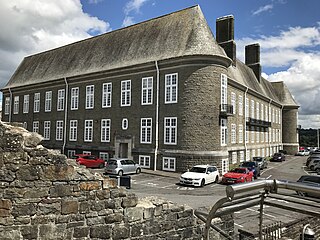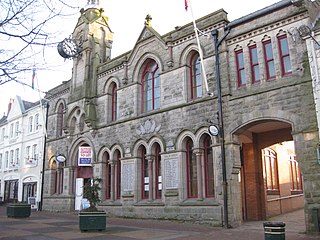
Frederick Archibald Vaughan Campbell, 3rd Earl Cawdor,, styled Viscount Emlyn from 1860 to 1898, was a British Conservative politician. He served briefly as First Lord of the Admiralty between March and December 1905.

Newcastle Emlyn is a town on the River Teifi, straddling the counties of Ceredigion and Carmarthenshire in West Wales. It is also a community entirely within Carmarthenshire, bordered by those of Llangeler and Cenarth, also in Carmarthenshire, and by Llandyfriog in Ceredigion. Adpar is the part of town on the Ceredigion side of the River Teifi. It was formerly called Trefhedyn and was an ancient Welsh borough in its own right. The area including Adpar had a population of 1,883 according to the 2011 census.

County Hall is a municipal facility on Castle Hill in Carmarthen, Wales. The building, which is the headquarters of Carmarthenshire County Council, is a Grade II listed building.

Llanelli Town Hall is a municipal building in Church Street, Llanelli, Carmarthenshire, South Wales. The town hall, which was the headquarters of Llanelli Borough Council, is a Grade II listed building.

Maesteg Town Hall is a municipal structure in Talbot Street, Maesteg, Wales. The town hall, which was the headquarters of Maesteg Borough Council, is a Grade II listed building.

Conwy Guildhall is a municipal structure in Rose Hill Street, Conwy, Wales. The guildhall, which is the meeting place of Conwy Town Council, is a Grade II listed building.

Montgomery Town Hall is a municipal building in Broad Street, Montgomery, Wales. It served as the meeting place of Montgomery Borough Council and is a Grade II* listed building.

Holywell Town Hall is a municipal structure in the High Street in Holywell, Wales. The façade of the town hall, which is the only surviving part of the original structure, is a Grade II listed building.

Laugharne Town Hall is a municipal building in Market Street in Laugharne, Carmarthenshire, Wales. The structure, which is the meeting place of Laugharne Corporation, is a Grade II* listed building.

Llandovery Town Hall is a municipal building in Market Street, Llandovery in Carmarthenshire, Wales. The structure, which is used as the local public library, is a Grade II listed building.

Narberth Town Hall is a municipal building in the High Street, Narberth, Pembrokeshire, Wales. The structure, which is currently used as a shop, is a Grade II listed building.

County Hall, formerly Aberaeron Town Hall, is a municipal building in Market Street, Aberaeron, Ceredigion, Wales. The structure, which is now used as a public library, is a Grade II listed building.

Denbigh Town Hall, is a municipal building in Crown Lane, Denbigh, Denbighshire, Wales. The structure, which is the meeting place of Denbigh Town Council, is a Grade II* listed building.

Welshpool Town Hall, is a municipal building in Broad Street, Welshpool, Powys, Wales. The structure, which is the meeting place of Welshpool Town Council, is a Grade II listed building.

Pwllheli Town Hall is a municipal building in Penlan Street, Pwllheli, Gwynedd, Wales. The structure, which now operates as an arts centre, is a Grade II listed building.

Fishguard Town Hall is a municipal building in the Market Square, Fishguard, Pembrokeshire, Wales. The structure, which is the meeting place of Fishguard and Goodwick Town Council, is a Grade II listed building.

Crickhowell Market Hall, formerly Crickhowell Town Hall, is a municipal building in the High Street, Crickhowell, Powys, Wales. The structure, which accommodates market stalls on the ground floor and a café on the first floor, is a Grade II* listed building.

The Assembly Rooms in Presteigne, formerly Presteigne Town Hall, is a municipal building in Broad Street, Presteigne, Powys, Wales. The structure, which accommodates a public library on the ground floor and an arts centre on the first floor, is a Grade II listed building.

Kidwelly Town Hall is a municipal building in Lady Street, Kidwelly, Carmarthenshire, Wales. The structure, which was last used as a public library but is currently vacant, is a Grade II listed building.

The Old Shire Hall is a former judicial building in the High Street in Cardigan, Ceredigion, Wales. The structure, which is now used as a British Red Cross shop, is a Grade II* listed building.





















